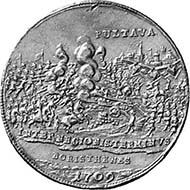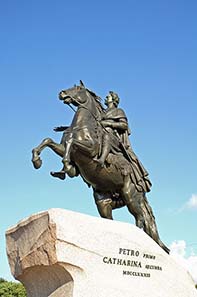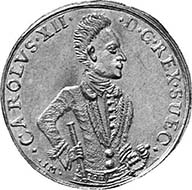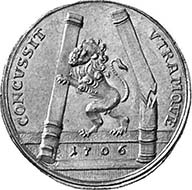In late autumn 1697, a 15 year-old king assumed the reins of government in Stockholm. Charles XII being juvenile seemingly made it an easy task for Denmark, Poland and Russia to extend their territory at Sweden’s expense. But there was one thing they had not reckoned with. Charles did not sit about in his capital at all and listened to his generals but took charge and went to battle. He was to return to Stockholm a dead man.
Russia. Peter I, 1689-1725. Gold medal 1709. On the Battle of Poltava. From auction Hess-Divo 300 (2004), 880.
After Denmark had been forced into peace and Poland had been defeated, Charles approached his third enemy which hitherto had been the only one succeeding in battle. Russia had divested Sweden of Narva and Dorpat and had founded St. Petersburg on Swedish territory. After first successes of the Swedes, Tsar Peter the Great managed to cut off Charles from his supplies. The result was starvation, and the cold Russian winter of 1708/1709 cost many Swedish soldiers their lives.
Battle of Poltava. Painting by Pierre-Denis Martin 1726. Source: Wikipedia.
Charles and his generals nevertheless maintained the siege of Poltava. That was the very place Peter intended to face the enemy. Skirmishes came about when the Russian vanguard tried to cross the Dnjepr river – or the Borysthenes, as it is called on our medal. For the first time in all his numerous military expeditions, Charles got seriously wounded: a Russian rifle bullet hit his left foot, entering at the heel and leaving again near the big toe. Several bones splintered. Charles is said to have resumed his ride of inspection nevertheless – when he arrived at headquarters, however, he fell off his horse, unconscious. During the next days, the wound became infected and the king was in a critical condition.
Until that time, the Swedish soldiers had stick to the superstitious thought that their leader was invulnerable. After all, he had always thrown himself into the fray. He had always come out unharmed. The king’s injuries had a demoralising effect on everyone, from the general to the youngest drummer. Peter, on his part, took the chance. He immediately ordered his whole army to cross over the Dnjepr river. The Russians moved on unfettered and set up their camp near Poltava. The Swedes, therefore, were trapped. There was no chance to back off without entering a fight. Charles, however, hesitated, and this reluctance enabled Peter to have a fortification built for his troops which was to wear down the Swedish army.
On June 28th, 1709, the decisive day had finally arrived.19,000 Swedish soldiers, enfeebled by frostbite due to the severe winter and months-long hunger, fought against 42,000 rested Russian soldiers. Charles likewise entered the battle, lying on a stretcher, able to look into the sky only, and utterly helpless. The Swedish plan was to fend off the Russians from their strong fortification in a surprise attack. But, the Swedes did not know how strong these camp fortifications really nor were they aware of the fact that the Tsar expected such a surprise attack and had made preparations. The Swedes were trapped. It is that precise moment our medal depicts.
In the background the city of Poltava can be seen as stated by the Latin legend, in the foreground the Djnepr river, which the die cutter called by its Latin name, Borysthenes. The legend says internecionis terminus, and that is a strong language. Terminus means end and internecio is butchery – hence, the Latin legend speaks of the end of the annihilation of the Swedes.
The iron equestrian: statue of Peter the Great. Photograph: Heidas / Wikipedia.
In the centre on can see an equestrian whose horse rears up, therewith assuming the position which was later taken up for the statue of Peter the Great in St. Petersburg. The medal, too, most possibly depicts the Tsar who is likely to have led his soldiers himself into the Battle of Poltava. He was easy to recognize, by his mere size, and hence exposed to the Swedish gunfire. Now, however, it was Peter who seemed to be invulnerable. He was hit three times: one bullet blew off his hat, another one was caught by his saddle, and the third one surely would have cost the Tsar’s life were it not for the silver icon Peter was wearing around his neck.
In the evening, the Swedes had lost the battle. Of 19,000 soldiers 6,901 were dead or injured, 2,760 were captured, 560 officers were lost and Charles was on the run.Voltaire, a contemporary, in his biography of Charles XII reports the following details about the escape of the Swedish king: …”Charles XII did not want to flee, he was not able to defend himself. Only Colonel Poniatowsky … was there with him. He signaled two followers, and they reached under the king’s shoulders and lifted him onto his horse, his excruciating pain notwithstanding. In this moment, Poniatowsky, who did not hold a command at the army, became leader, out of necessity. He collected 500 horsemen to accompany the king … This small band was vitalized by the sight of the king. Weapons produced, they made their way to the Swedish troops while encountering more than ten Russian regiments. During the scampered escape, the king’s horse got killed. Colonel Gierta, who likewise had suffered severe injuries, yielded his horse to him. In the course of fleeing, therefore, the hero who did not manage to stay in the saddle without support had to be lifted onto the horse twice.
In the face of all the misfortune, that retreat counted for much, but the flight was not over yet.
With the baggage, Count Piper’s state coach was found. After his departure from Stockholm, the king had not entered a coach. Now, he was put into the carriage – the horses were driven over hedge and ditch toward the Dnjepr. From the moment he was placed on the horse until the arrival at Piper’s coach Charles XII had not said a single word. Now, he was asking about the fate of Piper. He has been captured, along with the entire chancellery, so he was answered. And what about General Rehnskjöld and the Duke of Wurttemberg?, so he continued to inquire. Captured, Poniatowsky replied. Captured by the Russians!, Charles exclaimed. Come on, we better head for the Turks then.”
Charles XII, 1697-1718. On a coin from the Swedish territories: Pomerania. Double ducat 1706. From auction Hess-Divo 300 (2004), 386.
Charles XII indeed took refuge with the Ottoman Empire. Until 1714, he stayed in the small town of Bender, present-day Moldavia, and tried to talk the Turks into a war – albeit without success. In those years, the Swedish Empire fell to pieces. All surrounding princes grabbed their bits from the legacy. Charles could do nothing but stand by and watch. Although he returned to Sweden once again and managed to assemble an army – this time with the objective to attack Norway –, on November 30th, 1718, he was deadly hit by a bullet during the siege of Frederikshald. The campaign was put to a halt immediately. Sweden could never regain its former prominence again.











